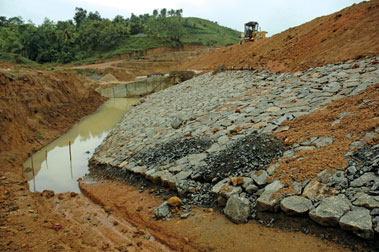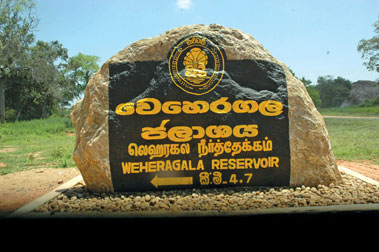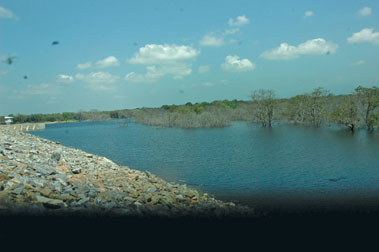Rebirth of hydraulic civilisation in Sri Lanka
 I
am firmly of the view that a new approach is necessary to resolve
problems faced by farmers. This new approach has to be vastly different
from the election promises given by politicians who represent the elite
and live in luxury mansions in Colombo and are therefore attempting to
force alien values on our farming community.” - Mahinda Chinthana I
am firmly of the view that a new approach is necessary to resolve
problems faced by farmers. This new approach has to be vastly different
from the election promises given by politicians who represent the elite
and live in luxury mansions in Colombo and are therefore attempting to
force alien values on our farming community.” - Mahinda Chinthana
Walter LIYANARACHCHI
The irrigation industry in Sri Lanka is functioning under the
guidance of Ports, Aviation and Irrigation Minister Chamal Rajapaksa.
His Ministry is one of the most important Ministries.
Access to water and irrigation is a major determinant of paddy
cultivation and the stability of yields.
The rapport between water resource and agriculture will not survive
without irrigation. Since Sri Lanka is an agro-based country, from time
immemorial, the value of a systematic irrigation scheme was felt by the
Sri Lankan rulers from 1948. The first multi-purpose reservoir project
during the regime of D.S.Senanayake came into existence in 1949. During
1940’s several other projects such as Minipe, Nalanda Oya, Kandalama
tank, Dambulla wewa, Walawe reservoir, Kirindi Oya reservoir, Kantale
augmentation scheme, Parakrama Samudra, Nuwarawewa, Heda Oya reservoir
were considered to be rehabilitated and came under investigation.
 |
|
Kekiri
Oboda tank construction in progress |
However during the recent past the rulers paid less attention to
improving the irrigation works in the country.
It is reported that except rehabilitating few tanks, no large
projects to develop irrigation have been implemented. Realising the
importance of developing the irrigation works in Sri Lanka, the present
govertnment believed that self- suffciency could only be achieved
through a strong and systematic irrigation system. In view of this fact,
President Mahinada Rajapaksa had drawn a special program to streamline
the planned proposals to develop irrigation works in Sri Lanka.
The concept was penetrated so hard, the President embodied a clause
in his policy statement - ‘Mahinda Chintana’. It states: “Our farmers
undergo severe suffering due to the scarcity of water, non-availability
of land, crop losses, poor markets for their produce and lack of access
to technology. I am fully aware and familiar with their problems and
expectations.
Hence, I am firmly of the view that a new approach is necessary to
resolve problems faced by farmers. This new approach has to be vastly
different from the election promises given by politicians who represent
the elite and live in luxury mansions in Colombo and are therefore
attempting to force alien values on our farming community.”
“Water is one of the prime resources of our country. The owners of
this valuable resources should be the pe of this country. I will firmly
assure this position.”
“I intend to present a national irrigation plan where the main
rivers, regional tanks, anicuts and water streams in villages will be
connected. Dry lands in the North, South, East and West will be
transformed to fertile agricultural lands”.
Taking a serious note to improve the irrigation works in Sri Lanka,
President had entrusted this difficult task to Irrigation, Port and
Aviatiohn Minister Chamal Rajapaksa who has a wide knowledge in
irrigation systems. Minister Rajapaksa formulated plans with the
assistance of the engineers, a large number of new projects and the
Irrigation Officials readily accepted the challenge and rehabilitated a
large number of major and minor irrigation schemes before schedule which
were neglected for a long time. Barren and abandoned cultivable lands
were converted to green paddy fields producing high yields.
 |
|
West bank
of the Kekirioboda tank |
The irrigation Department shying away the lethargic attitude,
suddenly invigorated with the government’s stimulation, commenced
implementing the proposed projects.
With the encouraging cooperation shown by the government towards the
Irrigation Department, the engineers and all concerned in the industry
flocked together to materialise the projects.
As a result of a constructive policy to develop the irrigation works
was drawn to meet the water requirement of the country.
At present the mission to meet the requirement of the policy is
achieved through the implementation of a series of programmes and
projects which can be broadly classified under the following areas.
a. Planning, design, construction and operation of infrastructure
facilitiies required to harness the surface water for land development.
b. Integrated natural resource management in major irrigation systems
in order to increase producitivity.
c. Assessment of water resources in river basin planning and dev
elopment, inclusive of stream flow forecasting and warning.
d. Increased beneficiary involvement through a joint system of
management in major irrigation schemes.
e. Providing drainage facilities to low lying areas and prevention of
flooding and salt water intrusion.
In order to achieve the above objectives, the Irrigation Department
has identified the following tasks. The establisment of the four
sub-departments within the Irrigation Department few years back was done
by keeping these under each of these sub departments are given below
 |
|
Stone
indicating the Weheragala direction |
a. Investigation, planning and designing of infrastructural elements
of water resources development for irrigation and flood control.
b. Construction of all major and mninor reservoirs, diversion weirs
and related structures for water delivery and agricultural development
in the down stream areas.
c. Operation and management of all major irrigation schemes including
the institutional strengthening in major irrigation systems.
With the assistance of the President and with the guidance of the
Minister the Irrigation Department could complete 90% of the planned
projects during the period 2009 and few are at the stage of completion.
The main projects are, Deduru Oya, Rambukkan Oya, Veli Oya, Veheragala,
Veemedilla reservoir and Kekiri Oboda.
Out of these projects the Veheragala and Kekiri Oboda tanks are newly
built reservoirs. The Veheragla tank project is completed and the Kekiri
Oboda project is underway.
During the recent past no government has undertaken to build new
tanks. Building a new tank is not an easy task since it involves many
matters. Firstly, a large amount of money has to be spent and an
efficient scientific expertise in hydraulic technogy is needed.
Deduru Oya Project
Deduru Oya Project involves directly local expertise and necessary
funds are provided by government coffers. The total expenditure is Rs.
6200 millions and with the completion of the project, 25,000 families
are to be benefitted.
 |
|
Weheragala
which is a new project completed recently |
The Deduru Oya, originating from the eastern boarder of the Central
Province is the main water source in the basin. It runs across
Kurunegala and Puttalam District and enters the sea at Chilaw. The total
length of the main stream of the river is about 115 km. and comprises of
9 tributories. The total land area falling under the basin is about 2600
square km out of which 3% is in”Central Province (Kandy and Matale
District) and the rest in the north western province 88% in Kurunegala
and 9% in Puttalam Districts. Nearly 50% of the families in the basin
are below poverty line and receive poverty alleviation assistance under
Samudhi programme from the government.
Rambukkan Oya Project
The prolject is implemented in Mundeni Oya Divisional Districts in
Ampara District. The tgank is being built across the Rambukkan Oya which
bears a cap,acity of 45,000 acre feet. When completed the new paddy
lands exceedng 3500 acres could be irrigated, an Irrigation Official
said.
The main dam is 3600 feet in length and the maximum height is 81
feet. The length of the main canal is 4.75 kilometers and the left
tributoty is 17 kms.
Maha Oya is being identified as a difficult area in which poverty is
prevailing. With the implementation of the project, the poverty
alleviation exercise could be doubled to a greater extent by providing
water to the needy farmer.
|



